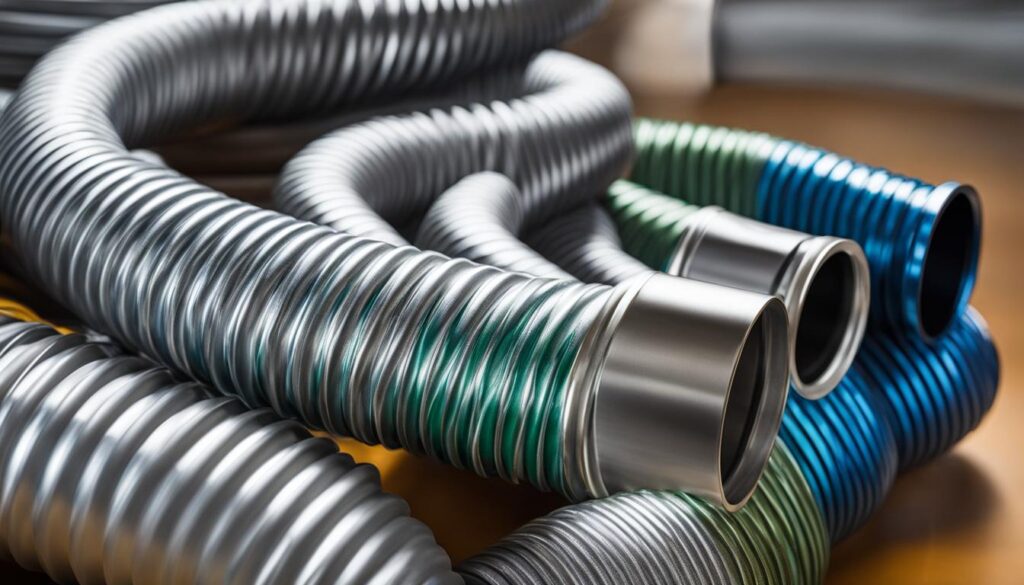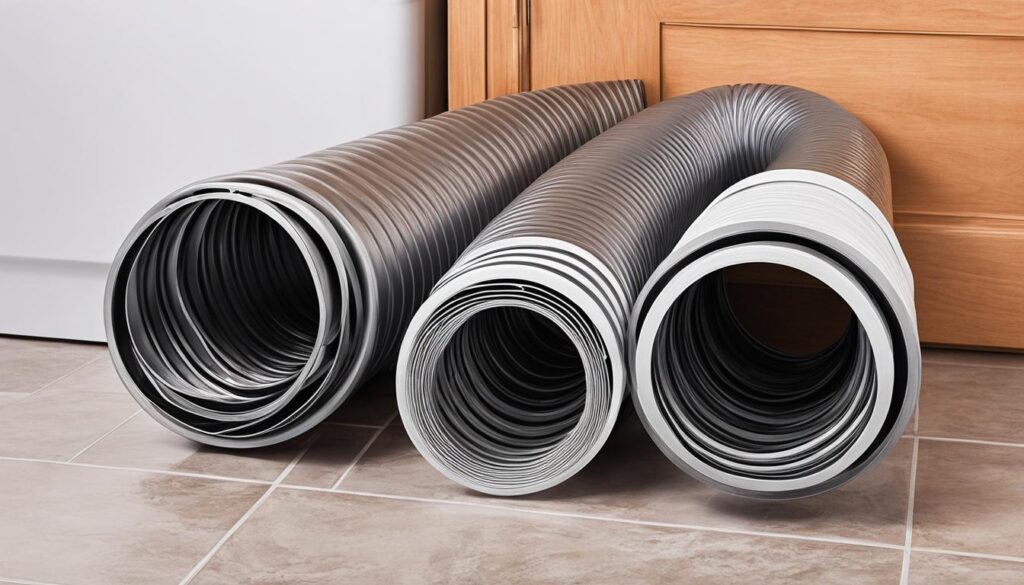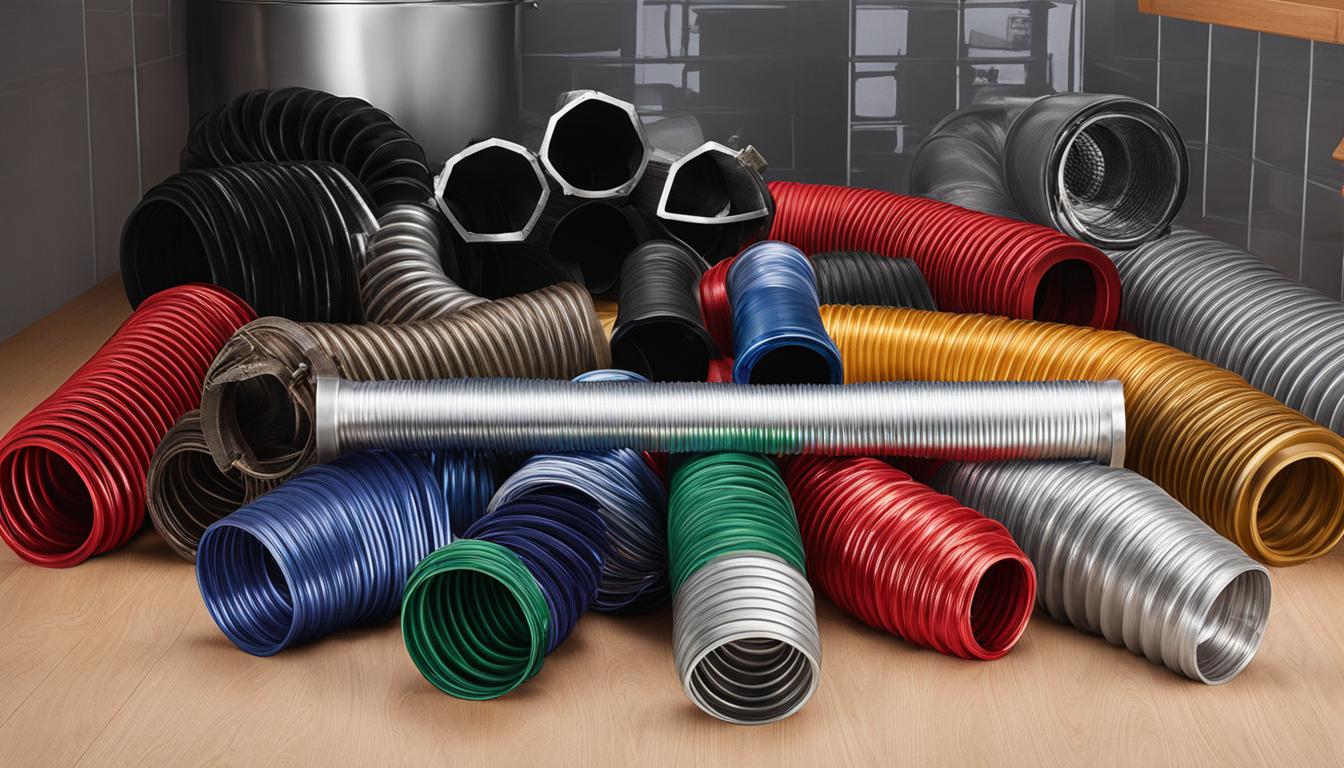Explore the best type of dryer vent hose options and different types of dryer vents available for safe and efficient drying. Our guide offers a detailed look at dryer vent hose varieties to help you make an informed dryer vent hose selection.
Types of Dryer Vent Hoses- Understanding Their Differences and Choosing the Best Option
The importance of dryer vent hoses is huge when it comes to drying your clothes safely and well. Good dryer vent hoses help air flow properly and stop lint from building up, which can cause fires. Knowing the different types out there is super important so you can pick what works best for you.
Overview of Different Types of Dryer Vent Hoses Available in the Market
There are a few types of dryer vent hoses you can find today, each with its own good and not-so-good points:
- Rigid Metal Duct: This type is made from strong materials like galvanized steel or aluminum. It’s really tough and lasts a long time. Plus, it’s fire-resistant, making it a safe choice for people who care about safety. Rigid metal ducts also help keep airflow steady and don’t collect lint easily.
- Semi-Rigid Metal Duct: This one mixes flexibility with strength. It’s easier to put in than rigid metal ducts and doesn’t kink as much. Semi-rigid ducts still let air flow well.
- Slim Duct: If you’re short on space, slim ducts are super thin and fit into tight spots where regular ducts just won’t work. They save space but still do their job well.
- Aluminum Foil Duct: These are cheap and light but not great for long-term use because they can tear easily. Aluminum foil ducts might be okay for temporary setups but should be changed often.
- Plastic or Vinyl Duct: These options are flexible and cost less, but they aren’t as tough as metal ones. They work fine for temporary uses but might not handle high heat very well over time.
Key Factors to Consider When Selecting a Dryer Vent Hose
When picking out a dryer vent hose, think about these key things:
- Material: Decide if you want metal or flexible options based on how tough you need it to be.
- Diameter: Make sure the hose size matches your dryer’s exhaust outlet so air flows right.
- Length: Measure how far your dryer is from the outside vent to get the right length.
- Flexibility: Check how easy it is to install the hose based on your space.
Choosing the right material can really change how safe and efficient your laundry area is!
Tips for Proper Installation and Maintenance of Dryer Vent Hoses
Installing your dryer vent hose correctly is super important for safety:
- Make sure all connections are tight using clamps that fit your hose type.
- Avoid sharp bends that could block airflow; smooth curves work best.
For maintenance:
- Clean out lint buildup regularly with a lint brush or vacuum.
- Look at your hoses now and then for any leaks or damage.
By following these tips, you’ll lower fire risks linked to poorly kept dryer vents while keeping everything working well in your laundry room!
Types of Dryer Vent Hoses- A Closer Look at Their Characteristics
Choosing the right dryer vent hose is super important for safety and how well your dryer works. There are different types of dryer vent hoses, and each one has its own special features. Let’s break them down!
Rigid Metal Duct
Rigid metal duct is a top pick for dryer venting because it’s strong and can handle high heat. It’s made from materials like galvanized steel or aluminum. This type of duct has a smooth inside that helps air flow easily, which keeps lint from building up.
- Durability: These ducts last a long time.
- Fire Resistance: They’re safer than many other materials.
- Airflow Efficiency: The smooth surface helps air move better.
Semi-Rigid Metal Duct
Semi-rigid metal duct looks a bit different because it has a flexible coil design. This makes it easier to install in tight spots. It doesn’t kink easily, which means good airflow even if you have to bend it around corners.
- Flexibility: Great for fitting into tricky spaces.
- Kink Resistance: Less likely to get stuck or twisted.
- Airflow Maintenance: Keeps air moving well, even with bends.
Slim Duct
Slim duct is super thin and perfect for small spaces or narrow walls. It can be made from plastic or metal, giving you options based on what you need. Even though it’s slim, it still allows enough airflow, making it great for apartments or homes where space is tight.
- Space-Saving Design: Fits in narrow areas without trouble.
- Material Choices: Comes in both plastic and metal.
- Adequate Airflow: Works well despite its smaller size.
Aluminum Foil Duct
Aluminum foil duct is often used for temporary setups because it’s light and cheap. But be careful! It can tear easily and isn’t the best choice for long-term use. If you do use this type, make sure to take good care of it.
- Cost-effective: Good option if you need something quick.
- Lightweight: Easy to move around during installation.
- Limitations: Not meant for permanent setups due to its fragility.
Plastic or Vinyl Duct
Plastic or vinyl ducts are flexible and usually cheaper than metal ones. They work well for short distances but might not last as long under high temperatures or heavy use.
- Flexible Design: Easy to work with when installing.
- Affordability: Generally less expensive than metal options.
- Durability Concerns: Might not hold up as well over time.
Key Considerations When Choosing Dryer Vent Hoses
When picking the right dryer vent hose, keep these things in mind:
Material Durability:
- Think about how long you want the hose to last and how much heat it needs to handle.
Diameter Matching:
- Make sure the diameter fits your dryer’s exhaust outlet perfectly.
Length Requirements:
- Check how far your dryer is from the outside venting point so you get the right length.
Flexibility Needs:
- Decide how easy it’ll be to install based on your setup’s layout.
By knowing these details about each type of dryer vent hose—from rigid metal ducts to flexible options—you can make a smart choice that keeps your laundry room safe and efficient!

Choosing the Right Dryer Vent Hose for Your Needs
When picking a dryer vent hose, there are some key things to think about. Choosing the right one helps your dryer work better and keeps your home safe from fire risks.
Diameter of the Hose
- Match the Size: Make sure the hose size fits your dryer’s exhaust outlet. If it doesn’t match, airflow can get blocked, making drying less effective.
- Standard Sizes: Most home dryers use a 4-inch diameter hose.
Length of the Duct
- Measure Carefully: Check how far it is from your dryer to the outside vent.
- Keep It Short: Try to keep this length short. Longer ducts can trap more lint and reduce airflow, which makes your dryer work harder.
Material of the Duct
The material you choose affects how long it lasts and how well it works:
- Rigid Metal Ducts: These are often best because they resist fire and last longer. They stay in shape better, allowing air to flow freely.
- Flexible Options: While these are easier to install, they can collect lint faster than smooth rigid ducts.
Flexibility
Flexibility matters when installing:
- Tight Spaces: Flexible designs can fit into small areas easily.
- Lint Buildup: But remember, they tend to gather lint more quickly than rigid options.
Cost Considerations
There are many affordable options out there, but spending a bit more on a quality duct is smart:
- Long-Term Savings: A good duct will save you money on repairs later because it’s built to last.
Additional Features
Look for features that might help:
- Insulation: Insulated hoses keep temperatures steady and reduce noise while your dryer runs.
- Antimicrobial Properties: Some ducts have coatings that stop mold growth, which helps keep air clean.
Key Considerations for Selecting Your Dryer Vent Hose
Following local building codes is super important when putting in a new dryer vent hose:
- Check Regulations: Local codes might say what materials you should use and how to install them safely.
- Regular Inspections:
- Look at your ductwork often for any signs of wear or damage.
- Keep an eye out for anything that could block airflow.
- Air Movement Pathways:
- Avoid sharp bends in the ductwork since they can slow down air movement.
- Make sure all connections are tight using clamps meant for your chosen material.
By keeping these tips in mind when choosing your dryer vent hose, you’ll not only improve its performance but also help keep your home safe from fire risks linked with lint buildup.
Choosing the right type of dryer vent hose means thinking about size, length, material choice, flexibility needs, cost considerations, and extra features that fit your home’s setup. Whether you’re doing it yourself or getting help replacing old hoses with newer ones designed for better airflow—making smart choices leads to smoother operation from your laundry appliances while keeping potential hazards at bay related to poor ventilation practices.
Maintaining and Troubleshooting Dryer Vent Hoses- Ensuring Optimal Functionality
Keeping your dryer vent hose in good shape is super important. It helps your dryer work better and keeps your home safe from fire hazards. Here are some handy tips to make sure everything runs smoothly.
Regular Cleaning
Cleaning your dryer vent hose regularly is key to stopping lint buildup. Lint can block airflow, making your dryer less effective and increasing the risk of fires. Here’s how to clean it well:
- Use the Right Tools: Grab a lint brush or a vacuum made for this job. These tools help you get deep into the ductwork.
- How Often to Clean: Try to clean the vent at least once a year. If clothes take longer to dry, clean it more often.
- DIY or Professional Help: You can clean it yourself, but sometimes hiring a pro ensures all lint and debris are removed.
Checking for Damage
Look over your dryer vent hose now and then to spot any problems:
- Signs of Wear: Check for cracks, tears, or holes in the hose. These issues can let hot air and lint escape, which is dangerous.
- When to Replace: If you see any damage, replace those hoses right away. Using UL-listed ducts keeps things safe and meets building codes.
Troubleshooting Common Problems
Knowing common problems can help you fix things quickly:
- Poor Airflow: Weak airflow might mean a clogged hose. Cleaning out the duct usually fixes this.
- Excess Lint or Moisture: If you see lots of lint around the hose or extra moisture nearby, that could mean there’s a blockage that needs fixing.
- Burnt Smell or Smoke: A burnt smell or smoke from the hose is serious! Unplug your dryer immediately and check for blockages in the ductwork.
Professional Inspection
Think about getting regular checks from a qualified technician who knows about dryer vent cleaning services:
- Thorough Assessments: Pros can give detailed evaluations of your ventilation system.
- Meeting Codes: They make sure everything follows building codes related to ventilation, which helps keep things safe.
By sticking with these maintenance tips and fixing problems quickly, you’ll boost how well your dryer works while lowering fire risks linked with bad ventilation systems.
Keep Your Dryer Safe!
Taking care of your dryer vent hoses is super important for both safety and performance! Regular cleaning, checking for damage, troubleshooting issues fast, and calling in experts when needed will help you have safer laundry days at home!

Innovative Advancements in Dryer Vent Hose Technology
The world of dryer vent hoses is changing fast! These changes are all about making things safer and more efficient for your home. Let’s dive into what’s new and exciting in dryer vent hose technology.
New Materials and Construction Techniques
One big change is the use of new materials and construction techniques. Companies are now using:
- Fire-resistant materials: These help keep your home safe by reducing fire risks from lint.
- Flame-retardant designs: If a fire does start, these materials make it harder for the flames to spread.
These improvements not only boost safety but also make hoses last longer. For instance, hoses made from special polymers can handle high temperatures without breaking down.
Smart Vent Hoses
Another cool development is the rise of smart vent hoses. These smart systems come with features like:
- Monitoring airflow: They check how air moves through the hose to keep drying conditions just right.
- Detecting blockages: If there’s a blockage, these systems send alerts so you can fix it quickly.
By adjusting airflow automatically, smart vents help you dry clothes faster while saving energy. This means less time doing laundry and lower bills!
Eco-Friendly Options
With more people caring about the environment, many companies are creating eco-friendly options for dryer vent hoses. Key features include:
- Energy-efficient designs: These use less energy while they work.
- Recycled materials: Many products now include recycled parts to cut down on waste.
Choosing eco-friendly options helps protect our planet and appeals to those looking for green home solutions.
Upcoming Trends in Dryer Vent Hose Technology
Looking ahead, we might see even more exciting trends in dryer vent hose technology:
- Integrated sensors: Future models could have sensors that check humidity levels to improve drying times.
- Automatic cleaning mechanisms: Imagine having a self-cleaning feature that stops lint buildup without you having to lift a finger!
Research into better duct materials continues, promising a safer and more efficient laundry experience for everyone at home.
Staying updated on advancements in dryer vent hose technology helps homeowners choose wisely. By focusing on safety and efficiency, you can find products that fit your needs while keeping your home safe!

